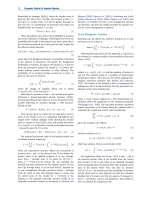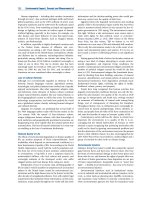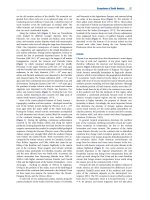Encyclopedia of biodiversity encyclopedia of biodiversity, (7 volume set) ( PDFDrive ) 5146
Bạn đang xem bản rút gọn của tài liệu. Xem và tải ngay bản đầy đủ của tài liệu tại đây (44.99 KB, 1 trang )
512
Glossary
Iteroparity The fact of being capable of repeat breeding, or
the process of doing this. Compare SEMELPARITY.
Iteroparous Capable of breeding more than once.
ITCZ Intertropical convergence zone.
ITQ Individual transferable quota.
IUCN International Union for Conservation of Nature; a
global environmental organization dedicated to conserving
biodiversity, founded in 1948 and based in Switzerland.
Noted especially for the IUCN Red List (see next).
IUCN Red List A widely cited, comprehensive compilation
of the extinction risk of species on a local or global basis. In
full, IUCN Red List of Threatened Species.
Jack Term for a sexually precocious male salmon that spends
one winter or less at sea before returning to its natal stream
to spawn.
Joint determination The fact that ecological and economic
systems mutually affect each other.
Jumping gene Another term for a TRANSPOSON.
Kaldor–Hicks efficiency An economic condition in which
those participants who are made worse off by a change to the
system could in theory be compensated by those who are
made better off, and would be willing to accept this
compensation. An alternative to the economic equilibrium
described by PARETO EFFICIENCY. [Named for the British
economists Nicholas Kaldor and John Hicks.] Also known as
potential Pareto efficiency.
Karst A landscape in which the primary geomorphic agent is
solution rather than erosion; typically formed in carbonates,
landforms including caves, sinkholes, blind valleys, and large
springs.
Kelt A spawned-out Atlantic salmon or steelhead that is
returning to the ocean to recuperate and spawn again.
Key innovation A property of a species that promotes the
process of speciation.
Key-industry species Prey of intermediate trophic status that
support a large group of consumers.
Keystone species A species whose effects on the
structure, dynamics, and functioning of the community is
disproportionately large relative to its abundance. Also,
keystone.
Kinetic energy See ENERGY.
Kleptoplastic Having the ability to harvest chloroplasts from
algae; these are then used by the secondary host to make
photosynthetic products. This phenomenon is kletoplasty.
Koinobiont A parasitoid that develops on a mobile,
active host.
Korarchaeota A proposed third kingdom within the domain
Archaea, including a small group of ribosomal RNA sequences
retrieved from geothermally heated sediments. [From Greek
koros, young man and archaios, ancient; for the early
divergence of this group during the ancient evolution of the
Archaea.]
Kranz anatomy Specialized anatomy of the C4 plant leaf in
which the bundle sheath (BS) tissue is enlarged and enriched
with chloroplasts, whereas the mesophyll is reduced in size
and often forms a lighter green halo around the BS. This
produces a wreath-like (‘Kranz’ in the original German)
appearance.
K-T An abbreviation for Cretaceous-Tertiary, usually in
reference to the K-T event or boundary (see next).
K-T event A notable large-scale extinction event occurring
about 65 million years ago, at the boundary of the Cretaceous
and the Tertiary (K-T boundary), involving the extinction of
about 70 percent of extant species, including the dinosaurs
and many other land-dwelling vertebrates.
Kuznets curve A hypothesized trend in which pollution and
other environmental degradation initially rise, then level off,
and eventually decrease as incomes increase and the national
economy develops. [Proposed by the Russian-American
economist Simon Kuznets.]
Kwongan Evergreen heathlands that cover extensive areas of
southwestern Australia.
Land cover The physical materials covering the surface of the
earth, natural or man-made; e.g., water, forests, grassland, bare
ground, buildings, roads, and so on.
Land degradation Reduction or loss of the biological and
economic productivity and complexity of terrestrial
ecosystems; see DEGRADATION.
Land equivalent ratio (LER) The area needed for sole
cropping to produce the same amount of crops as would be
produced in one hectare of intercropping or mixed cropping.
Land ethic A philosophy of proper treatment of lands and
the natural communities on them, as opposed to valuing land
merely as property.
Landrace A traditional local variety of a domesticated
animal or plant species that has developed largely by natural
processes, through adaptation to the physical and cultural
environment in a given geographic region. The term
TRADITIONAL VARIETY is sometimes applied to plant landraces.
[From the sense that it is a race (breed) peculiar to the land
where it lives.]
Landscape 1. The visible features of an area of the natural
terrestrial world, including physical aspects such as mountains
or rivers, and also native vegetation. 2. A specific area having
consistent features of this type; e.g., a desert or forest
landscape.
Landscape complementation The degree to which a
landscape provides all necessary cover types for a species that
requires multiple cover types to complete its life cycle.
Landscape connectivity See CONNECTIVITY.
Landscape fragmentation See FRAGMENTATION.
Landscape heterogeneity The variability in land cover types
within a given landscape.
Landscape legacy The long-term impact of historical events
on ecosystem structure, composition, or function.
Landscape matrix See MATRIX.
Landscape patch See PATCH.
Land sparing The spatial separation of biodiversity
conservation from agriculture.
Land use The set of human activities within a landscape and
their impacts on natural processes, such as physical, chemical,
and biological cycles. Land use is often classified in major
categories such as cropland, pasture, plantation forest, and
natural forest.
Land-use change The changes in the way land is used at a
given location, for example, when a forested land is converted
to agricultural fields or when a forestry plantation is changed
to other types of use.
La Nin˜a Southern Oscillation See EL NIN˜O SOUTHERN
OSCILLATION.









